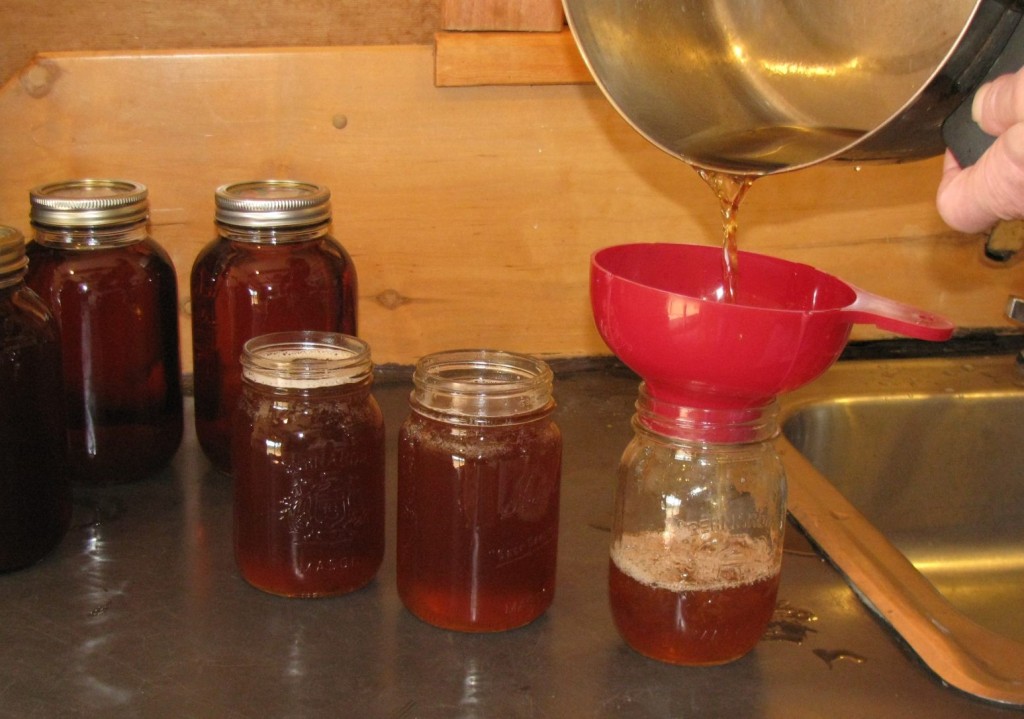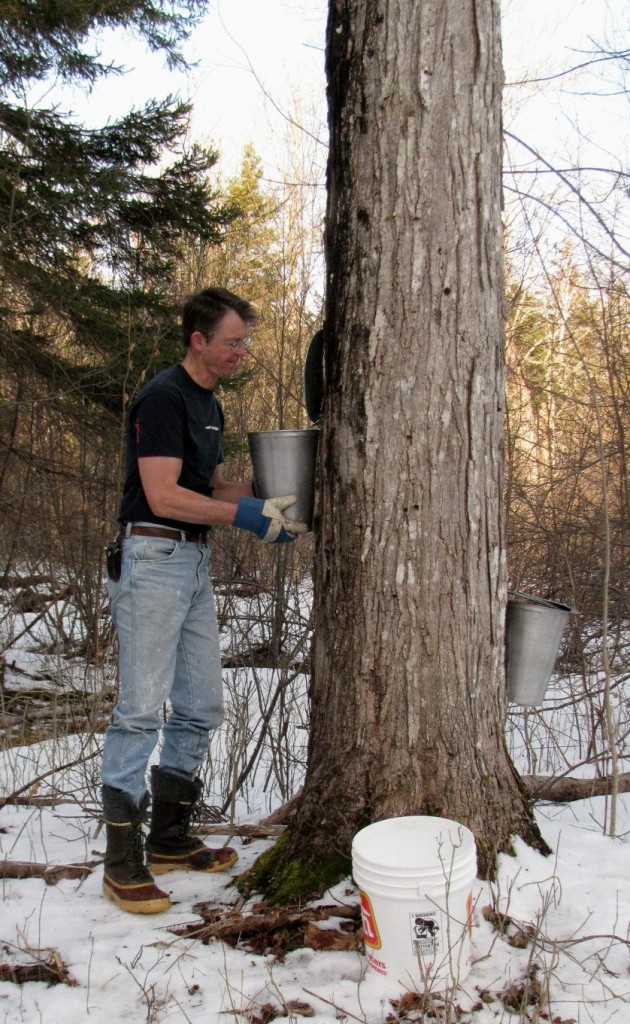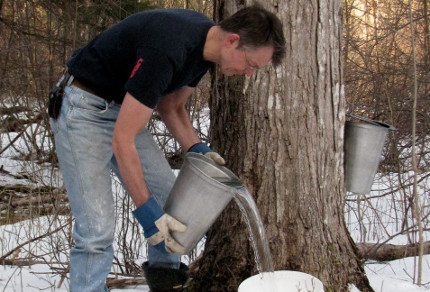
Home-made Maple Syrup (© Magi Nams)
Each year, I chalk up signs of spring: the mild south winds I call ‘yearning winds,’ the arrivals of migratory songbirds, the appearance of pussy willows and snowdrops, the night chorus of spring peepers, the scent of boiling maple sap on the air. All are evocative, but the boiling of maple sap into syrup represents the first harvest of the year and the promise of delicious pancake and waffle beakfasts during the months to come.

Maple Sap Dripping into Sap Bucket (© Magi Nams)
In Canada, sugar maples range from southern Ontario eastward through southern Quebec and throughout the Maritime provinces of New Brunswick, Nova Scotia and Prince Edward Island.1 When late winter/early spring temperatures drop below freezing at night and rise above freezing during the day, the maple sap begins to run, pulled upward from roots to twigs and leaf buds. Carrying stored plant sugars, the clear watery sap has a faint sweet taste. When concentrated via boiling, that faint sweetness intensifies into the rich flavour of maple syrup.
Each spring, Vilis puts out 11 taps in five big sugar maples growing on our property beside Matheson Brook. To tap a maple, he drills a 1/2″-diameter hole in its trunk and then hammers a metal spile or spigot into the hole to drain sap into a bucket he hangs beneath the spile. He positions a metal lid over the spile and bucket to prevent bits of bark and other debris from falling into the sap in the bucket.

Vilis and Pepper en route to Sugar Maples (© Magi Nams)
This year, Vilis ran his taps for two weeks, finishing last Saturday after soaring daytime and overnight temperatures reduced sap flow. He checked the buckets each day, and sometimes twice a day if the sap was running fast. I accompanied him twice, drinking in the cold sweet air as we walked through parkland and mixed forest behind our house to the maples scattered along the brook edge. Vilis pulled a toboggan, on which he had lashed two large plastic containers which would hold the sap during the return trip.

Vilis Collecting Maple Sap (© Magi Nams)
When we reached each of the tapped maples, we poured the maple sap, some of it frozen, into a large bucket and then tranferred the sap to the containers on the toboggan. This sounds straightforward, but to collect sap from three of the sugar maples, we crept down a steep slope, clinging to trees, sometimes slipping or going for a slide in the snow. Then Vilis lugged the heavy bucket of sap back up that slippery slope. There’s nothing like a little adventure to add to the sweetness of the maple syrup!
Commercial maple syrup producers use networks of plastic tubing to collect maple sap from taps and transport it directly to their evaporators. Last year in Nova Scotia, 61 commercial producers collected sap from over 370,000 taps and evaporated it into 143,000 litres of syrup.2

Vilis Emptying a Full Sap Bucket (© Magi Nams)
Many Nova Scotians boil up some syrup just for themselves, like we do. Twice a week, Vilis split a pile of hardwood and set up his small stainless steel evaporator over an outdoor fire. All day, we fed the fire and poured more sap into the evaporator, boiling it down until it was thick enough to finish the process in the house, where Vilis could more easily monitor the syrup’s thickness. The syrup bubbling into a froth signaled its readiness, and he poured it into sterilized jars, sealing them for storage in our pantry. Each time we pour our home made maple syrup onto pancakes or waffles, along with its sweetness we taste the cold fresh air of early spring, the excitement of creeping and sliding down a steep slope to waking maples, the scent of woodsmoke and maple on the air.
References:
1. R.C. Hosie. Native Trees of Canada, 7th edition. 1975. Canadian Forestry Service, Department of the Environment, Ottawa, p. 266.
2. Maple Producers Association of Nova Scotia. 2011 Maple Industry Situatioan Report http://www.novascotiamaplesyrup.com/


